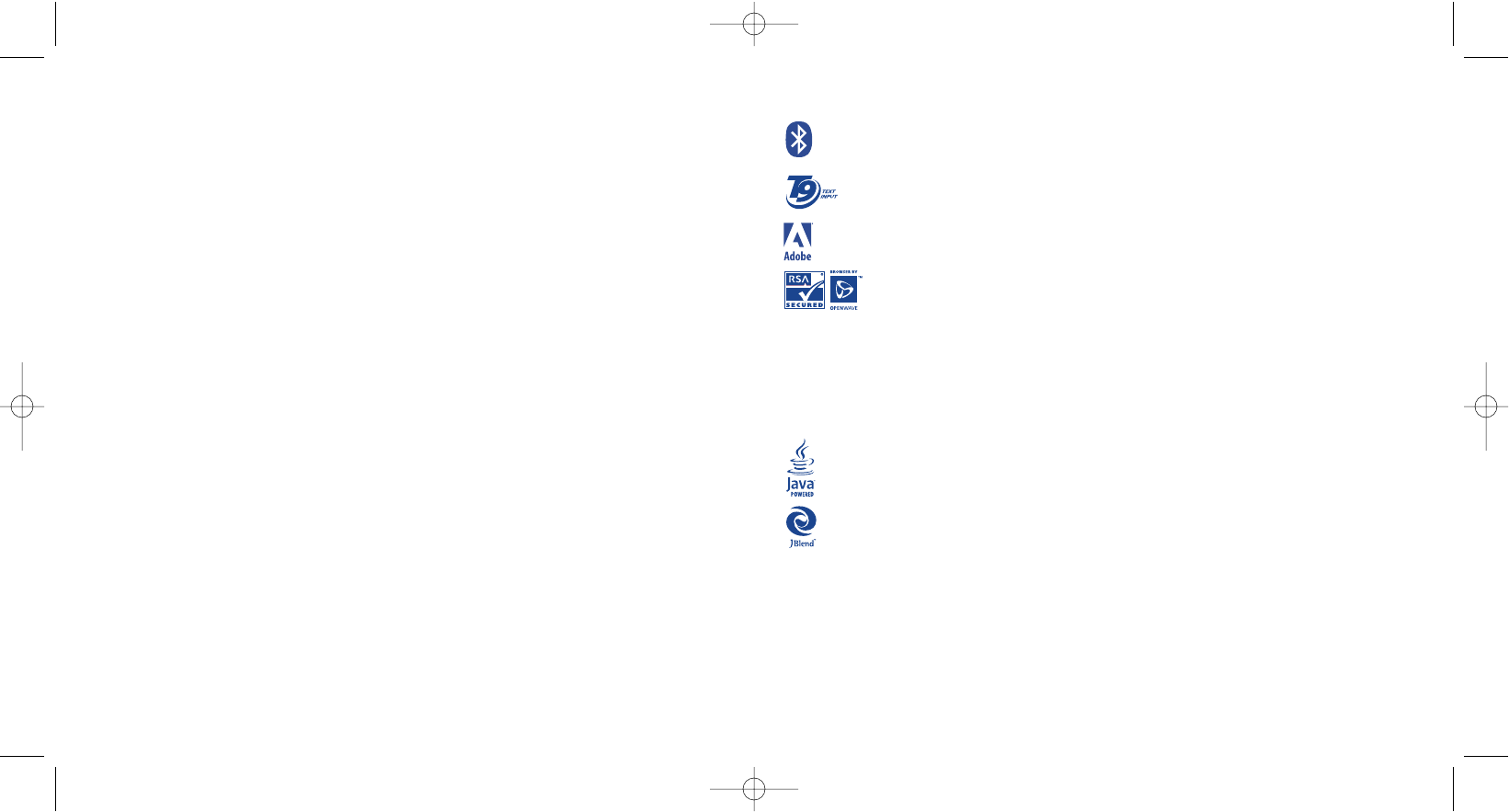
• LICENCES
miniSD™ is a trademark of SD Card Association
The Bluetooth word mark and logos are owned by the Bluetooth SIG,Inc. and any use of such marks by T&A Mobile Phones
Limited and its affiliates is under license.Other trademarks and trade names are those of their respective owners.
T9 Text Input is licensed under one or more of the following:U.S.Pat.Nos.5,187,480,5,818,437,5,945,928, 5,953,541,6,011,554,
6,286,064,6,307,548,6,307,549,and 6,636,162, 6,646,573; European Pat.Nos.0 842 463 (96927260.8),1 010 057 (98903671.0),
1 018 069 (98950708.2);and additional patents are pending worldwide.
Adobe®,the Adobe® logo,Adobe Reader®,Photoshop® Album,Photoshop® Album Starter Edition and Photoshop® Elements
are either registered trademarks or trademarks of Adobe Systems Incorporated in the United States and/or other countries.
The Wap navigator is the exclusive property of Openwave.For this reason,it is forbidden to modify,translate,disassemble
or even decompile all or part of the software that makes up the navigator.
Disclaimer
Downloading or running applications will not damage or alter any software already in your mobile telephone designed to support Java™
technology.T&A Mobile Phones Limited and its affiliates waive any responsibility and refuse to guarantee applications that are subsequently used,
as well as for all applications not embedded in the handset upon purchase.The purchaser alone bears the risk of loss,damage or defect of the
handset,or of applications/software,and generally of any damage or consequence resulting from the use of the said applications/software.In the
event the said applications/software,or the subsequent setup of any function are lost due to technical reasons if the handset is replaced/repaired,
the mobile phone owner should repeat the operation and download or set up again.T&A Mobile Phones Limited and its affiliates grant no
guarantee and disclaim any responsibility if the operation cannot be repeated or cannot be performed without incurring additional costs.
Java™ and all Java™ based trademarks and logos are trademarks or registered trademarks of Sun Microsystems,Inc.in the U.S.
and other countries.
Powered by JBlend™ - Copyright 1997-2003 - Aplix Corporation.All rights reserved.JBlend™ and all JBlend™-based trademarks
and logos are trademarks or registered trademarks of Aplix Corporation in Japan and other countries.
®
87
• CHARGERS
Mains powered chargers will operate within the temperature range of:0°C to 40°C.
The chargers designed for your cellphone meet with the standard for safety of information technology equipment and office equipment use.They
should be used for this purpose only.
Characteristics of power supply (depending on the country):
Tr avel charger: Battery:Lithium 810 mAh
Input:100-240 V, 50/60 Hz,0.15 A
Output:5 V, 500 mA
• RADIO WAVES:
THIS CELLPHONE MEETS THE GOVERNMENT’S REQUIREMENTS FOR EXPOSURE TO RADIO WAVES.
Your cellphone is a radio transmitter and receiver.It is designed and manufactured not to exceed the emission limits for exposure to radio-
frequency (RF) energy.These limits are part of comprehensive guidelines and establish permitted levels of RF energy for the general population.
The guidelines are based on standards that were developed by independent scientific organizations through periodic and thorough evaluation of
scientific studies.These guidelines include a substantial safety margin designed to ensure the safety of all persons,regardless of age and health.
The exposure standard for cellphones employs a unit of measurement known as the Specific Absorption Rate, or SAR.The SAR limit set by
public authorities such as the Federal Communications Commission of the US Government (FCC),the Australian Communications Authority
(ACA) or by Industry Canada,is 1.6 W/kg averaged over 1 gram of body tissue.Tests for SAR are conducted using standard operating positions
with the cellphone transmitting at its highest certified power level in all tested frequency bands.
Although the SAR is determined at the highest certified power level,the actual SAR level of the cellphone while operating can be well below the
maximum value.This is because the cellphone is designed to operate at multiple power levels so as to use only the power required to reach the
network.In general,the closer you are to a wireless base station antenna,the lower the power output of the cellphone Before a cellphone model
is available for sale to the public,compliance with national regulations and standards must be shown.
The highest SAR value for this model cellphone when tested for use at the ear is 0.2 W/Kg and for use close to the body is 0.34 W/Kg.While
there may be differences between the SAR levels of various cellphones and at various positions,they all meet the government requirement for
RF exposure.For body-worn operation,the cellphone meets FCC RF exposure guidelines provided that it is used with a non-metallic accessory
with the handset at least 2 cm from the body.Use of other accessories may not ensure compliance with FCC RF exposure guidelines.
The World Health Organization (WHO) considers that present scientific information does not indicate the need for any special precautions for
use of cellphones.If individuals are concerned,they might choose to limit their own or their children's RF exposure by limiting the length of calls,
or using "hands-free" devices to keep cellphones away from the head and body. (fact sheet n°193).Additional WHO information about
electromagnetic fields and public health are available on the following website:http://www.who.int/peh-emf.
Your telephone is equipped with a built-in antenna.For optimal operation,you should avoid touching it or degrading it.
M5_UM_FCC_07-10-05 7/10/05 15:15 Page 7


















